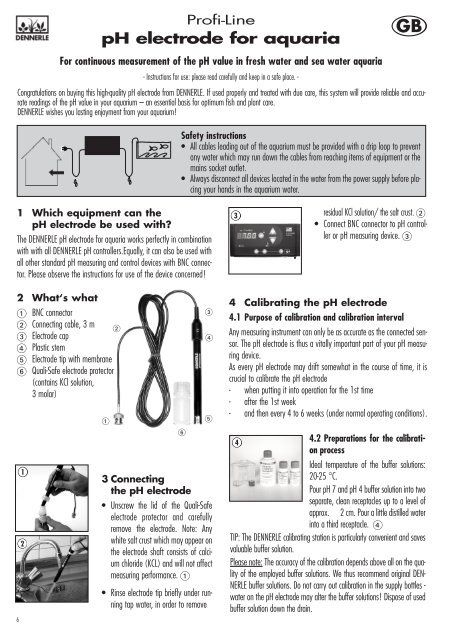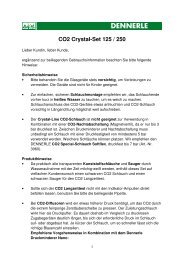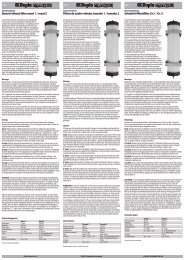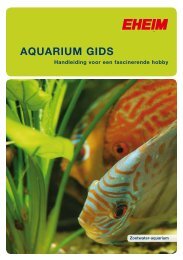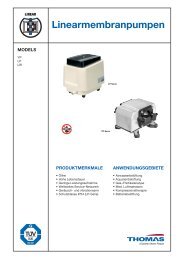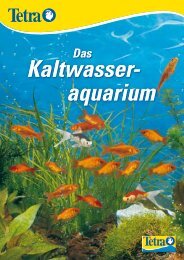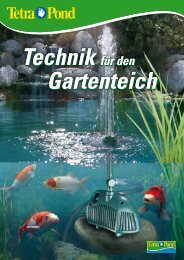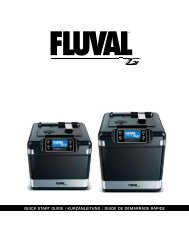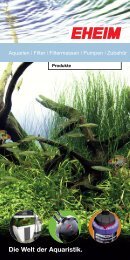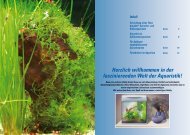GA pH-Elektrode - Der Aquaristik-Laden
GA pH-Elektrode - Der Aquaristik-Laden
GA pH-Elektrode - Der Aquaristik-Laden
Create successful ePaper yourself
Turn your PDF publications into a flip-book with our unique Google optimized e-Paper software.
<strong>GA</strong> <strong>pH</strong>-<strong>Elektrode</strong>:<strong>GA</strong> <strong>pH</strong>-<strong>Elektrode</strong> 03.11.2008 16:31 Uhr Seite 6<br />
� BNC connector<br />
� Connecting cable, 3 m �<br />
� Electrode cap<br />
� Plastic stem<br />
� Electrode tip with membrane<br />
� Quali-Safe electrode protector<br />
(contains KCl solution,<br />
3 molar)<br />
Profi-Line<br />
<strong>pH</strong> electrode for aquaria<br />
For continuous measurement of the <strong>pH</strong> value in fresh water and sea water aquaria<br />
- Instructions for use: please read carefully and keep in a safe place. -<br />
Congratulations on buying this high-quality <strong>pH</strong> electrode from DENNERLE. If used properly and treated with due care, this system will provide reliable and accurate<br />
readings of the <strong>pH</strong> value in your aquarium – an essential basis for optimum fish and plant care.<br />
DENNERLE wishes you lasting enjoyment from your aquarium!<br />
1 Which equipment can the<br />
<strong>pH</strong> electrode be used with?<br />
The DENNERLE <strong>pH</strong> electrode for aquaria works perfectly in combination<br />
with with all DENNERLE <strong>pH</strong> controllers.Equally, it can also be used with<br />
all other standard <strong>pH</strong> measuring and control devices with BNC connector.<br />
Please observe the instructions for use of the device concerned!<br />
2 What‘s what<br />
6<br />
1<br />
2<br />
�<br />
�<br />
�<br />
�<br />
�<br />
3 Connecting<br />
the <strong>pH</strong> electrode<br />
• Unscrew the lid of the Quali-Safe<br />
electrode protector and carefully<br />
remove the electrode. Note: Any<br />
white salt crust which may appear on<br />
the electrode shaft consists of calcium<br />
chloride (KCL) and will not affect<br />
measuring performance. �<br />
• Rinse electrode tip briefly under running<br />
tap water, in order to remove<br />
GB<br />
Safety instructions<br />
• All cables leading out of the aquarium must be provided with a drip loop to prevent<br />
any water which may run down the cables from reaching items of equipment or the<br />
mains socket outlet.<br />
• Always disconnect all devices located in the water from the power supply before placing<br />
your hands in the aquarium water.<br />
3<br />
residual KCl solution/ the salt crust. �<br />
• Connect BNC connector to <strong>pH</strong> controller<br />
or <strong>pH</strong> measuring device. �<br />
4 Calibrating the <strong>pH</strong> electrode<br />
4.1 Purpose of calibration and calibration interval<br />
Any measuring instrument can only be as accurate as the connected sensor.<br />
The <strong>pH</strong> electrode is thus a vitally important part of your <strong>pH</strong> measuring<br />
device.<br />
As every <strong>pH</strong> electrode may drift somewhat in the course of time, it is<br />
crucial to calibrate the <strong>pH</strong> electrode<br />
- when putting it into operation for the 1st time<br />
- after the 1st week<br />
- and then every 4 to 6 weeks (under normal operating conditions).<br />
4<br />
4.2 Preparations for the calibration<br />
process<br />
Ideal temperature of the buffer solutions:<br />
20-25 °C.<br />
Pour <strong>pH</strong> 7 and <strong>pH</strong> 4 buffer solution into two<br />
separate, clean receptacles up to a level of<br />
approx. 2 cm. Pour a little distilled water<br />
into a third receptacle. �<br />
TIP: The DENNERLE calibrating station is particularly convenient and saves<br />
valuable buffer solution.<br />
Please note: The accuracy of the calibration depends above all on the quality<br />
of the employed buffer solutions. We thus recommend original DEN-<br />
NERLE buffer solutions. Do not carry out calibration in the supply bottles -<br />
water on the <strong>pH</strong> electrode may alter the buffer solutions! Dispose of used<br />
buffer solution down the drain.


